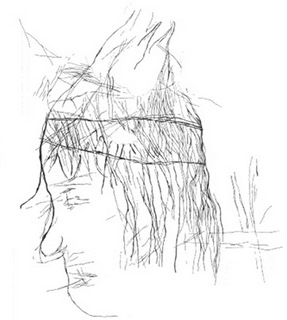The Mysterious Ringing Rocks
/This is rock music. Literally.
These chime-like sounds come from geological phenomena known as ringing rocks. Physically, they look no different from regular rocks, but it's not until you lightly strike them with a hammer that the rocks reveal their sonic secret.
Also known as sonorous rocks, these audio boulders can be found in various locations inside the 128-acre Ringing Rocks Park in Southeastern Pennsylvania, including Stony Garden in Bucks County, Devil's Race Course in Franklin, and Pottstown in Montgomery.
The most famous among visitors is located in Upper Black Eddy near the Delaware River. Framed by a lush forest and a majestic waterfall, the site features a vast eight-acre field of ringing rocks, with some stacked as high as 10-feet.
It was here that Dr. J. J. Ott performed for the Buckwampum Historical Society in June 1890, for what is probably the first rock concert in history.
According to Natural History Magazine, Ott "played several musical selections" while accompanied by a brass band. The performance highlighted the natural musicality of the rocks which he assembled into an octave scale.
Since Ott's performance, the site has attracted other musicians looking to compose one-of-a-kind soundscapes using the ringing rocks. Like instrumental percussionist group, Square Peg Round Hole, who recorded an original song using rocks they selected for their similar tonal qualities as their instruments.
Recordists like Philadelphia-based Thomas Rex Beverly also visit the park to take audio recordings of the rocks. He observed that changes in the environment also changed the sound of the rocks. Which means what the rocks sound in summer, isn't the same as they do in winter when layers of snow surround the rocks. The amount of snow also creates significant changes in the pitch of the rocks.
But a more interesting discovery is that, while only 30% of the rocks ring, they generally ring in the tone of B flat. Now, why is that more interesting than finding out the sound produced by the rocks are ultimately site specific, existing in synergy with its surroundings, wherein any incremental change can dramatically affect its acoustics, you might ask? Because B flat is what a supermassive black hole sounds like.
Back in 2003, NASA's Chandra X-Ray Observatory detected sound waves are coming from a black hole 250 million light years away from Earth. It turns out, it's been humming a B flat that's 57 octaves below middle C for close to 2.5 billion years.
It's out of this world tidbits like this, so to speak, that fuel the wild urban legends surrounding the origins and mechanisms of the ringing rocks. So in 1965 geologist Richard Faas performed numerous lab tests on the rocks to find out if there's a connection between the physical make up of the rocks and their ability to create sound.
What Faas found was an explanation to one of the most widely claimed myths about the ringing rocks. Unlike the stories, the rocks don't lose their ability to make sounds when taken out of the boulder field. They still produce a series of low-frequency sounds, which remain inaudible to the human ears until it's layered with similar low-frequency sounds coming from other ringing rocks.
But while he was able to debunk one myth, Faas still wasn't able to identify the specific physical evidence that would explain why the rocks ring. So instead of getting answers, all he raised are more questions.
Like, if the rocks were all made from diabase, a volcanic basalt that's high in iron and aluminium content, then why do only a few of the rocks ring? Why aren't the rocks in nearby areas of the field ring as well? And since diabase is the same substance as that of the Earth's crust, does this mean that the Earth is one giant bell?
And how did the boulders even get there in the first place? One theory suggests that when the supercontinent Pangaea shifted some 300 years ago, it caused mountains to erode and the sediments to settle in nearby valleys.
Magma worked its way up to the surface, depositing large amounts of diabase into the soil in the process. Scientists believe that the boulders were created from what they call the freeze-thaw cycle.
Where the water that's permeated the hardened mixture of magma and sediments goes into a loop of freezing and melting, which eventually split the giant rock formation into individual boulders.
This would make for a very satisfying explanation into the mystery of the ringing rocks, if only (1) there were volcanoes in Pennsylvania, and (2) well if it actually cracked its mystery.
But because even extensive scientific studies couldn't provide a definitive explanation on why the rocks ring, speculations of the more peculiar variety abound.
Some think the ringing rocks are surrounded by a bizarre magnetic field, rendering compasses unusable. It's also rumoured to be an ancient ceremonial site used by Native Americans, who used the rocks for their rituals.
Others believe the boulders are pieces of a meteorite that crashed on Earth, and the radiation is why there's no vegetation nor animals that settle in the boulder field.
Of course, we can't talk about the inexplicable without chocking it up to aliens.
Take Stonehenge. The ancient monument has never been a stranger to green space men and conspiracy theorists, even more so now that ringing rocks were discovered on the site.
Researchers from the Royal College of Art under their Landscape & Perception Project (L&P) project discovered that the bluestones (or the inner circle of Stonehenge) share the same musical ability as that of the boulders in Ringing Rocks.
Evidence showed that almost all of the rocks have scuff marks on places where it might have been struck. Proving, that the rocks were specifically chosen for their ability to make ringing sounds.
And by some strange coincidence, it just so happened that the stones were sourced from Preseli Hills, where a village named Maenclochog ̶ which translates to bell or ringing stones ̶ is located. Records show that the townspeople used bluestones as church bells until the 1800s.
To add to the mystery, recent archaeological findings reveal that Stonehenge is part of a complex network of 17 other previously unknown ancient structures including nearby Durrington Walls and Avebury.
Using sophisticated equipment like a ground-penetrating radar and a 3D laser scanner, the pioneering digital mapping project covered an area of 12-square kilometres or the size of 1,250 football fields.
What they discovered was a labyrinth of burial grounds, ritual sites, processional routes, and pre-historic trenches all seemingly converging towards the direction of Stonehenge as its centre.
Following various cultural studies, what links Stonehenge's bluestones and the boulder field in Pennsylvania is that the ringing rocks they're made of are considered sacred across different ancient civilizations. They were thought to contain powerful spirits and may have been used in religious ceremonial practices as a way to speak with the gods.
But no matter how similar the role of ringing rocks around the world are, in the context of history and culture, there's still not one physical characteristic that exists among all of them that could explain why they ring.
And so the mystery continues. Who knows, maybe it really is aliens, and the worlds one rocking intergalactic mixtape?
Sources:
New Music Video: Square Peg Round Hole at Ringing Rocks, http://www.phillymag.com/ticket/2016/01/20/new-music-video-square-peg-round-hole-at-ringing-rocks/
Watch This Band Create Music on 'Ringing' Boulders, http://mentalfloss.com/article/74267/watch-band-create-music-ringing-boulders
Great Natural Areas in Eastern Pennsylvania, https://books.google.com.ph/books?id=-AGm3Ny_NsgC&lpg=PA123&ots=07EIMk7EUW&dq=Buckwampum%20historical%20society&pg=PA124#v=onepage&q=Buckwampum%20historical%20society&f=false
Outbound Journeys in Pennsylvania: A Guide to Natural Places for Individual and Group Outings, https://books.google.com.ph/books?id=yN_G7nSkyFYC&lpg=PA47&ots=IlrR90HLzh&dq=Buckwampum%20historical%20society&pg=PA47#v=onepage&q=Buckwampum%20historical%20society&f=false
Ringing Rocks for wind ensemble and electronics by Thomas Rex Beverly Sound Libraries, https://soundcloud.com/trexbeverly/ringing-rocks-for-wind-ensemble-and-electronics
Have You Heard About B Flat? http://www.npr.org/templates/story/story.php?storyId=7442915
Travel Suggestions: 'Gates Of Hell' And Ringing Rocks Park, http://www.npr.org/2015/08/31/436229354/travel-suggestions-gates-of-hell-and-ringing-rocks-park
The 10 Best Adventures from the New Atlas Obscura Book, https://www.outsideonline.com/2117141/10-best-adventures-new-atlas-obscura-book
There’s No Other Park In America Quite Like This One In Pennsylvania, http://www.onlyinyourstate.com/pennsylvania/ringing-rocks-park-pa/
Strange & Unexplained - Ringing Rocks, http://www.skygaze.com/content/strange/RingingRocks.shtml
The Sonorous Stones of Ringing Rocks Park, http://www.atlasobscura.com/places/sonorous-stones-ringing-rocks-park
VIDEO: Rock music, http://scienceline.org/2017/06/video-rock-music-2/
Ringing Rocks, http://www.davidhanauer.com/buckscounty/ringingrocks/
Weird Geology: Ringing Rocks, http://www.unmuseum.org/ringrock.htm
The Ringing Rocks of Pennsylvania – A Famous Geological Oddity, http://www.odditycentral.com/travel/the-ringing-rocks-of-pennsylvania-a-famous-geological-oddity.html
Ringing Rocks Park really rocks, http://www.nj.com/times-sports/index.ssf/2012/07/ringing_rocks_park_really_rock.html
RECORDING THE STRANGE SOUNDS OF RINGING ROCKS:, https://www.asoundeffect.com/ringing-rocks-sounds/
If Rocks Could Sing: The
Ringing Rocks of Bucks Co., http://pabook2.libraries.psu.edu/palitmap/Ringing.html
These rocks can sing, http://articles.latimes.com/2011/apr/02/nation/la-na-ringing-rocks-20110403
Ontario Archaeological Society Arch Notes, http://www.ontarioarchaeology.on.ca/Resources/ArchNotes/anns4-5.pdf
We may have cracked the mystery of Stonehenge, http://www.bbc.com/travel/story/20170713-why-stonehenge-was-built
Stonehenge secrets revealed by underground map, http://www.bbc.com/news/science-environment-29126854
Are Stonehenge's Boulders Actually Big Bells?, https://www.theatlantic.com/technology/archive/2014/03/are-stonehenges-boulders-actually-big-bells/284239/
RCA Research Team Uncovers Stonehenge's Sonic Secrets, https://www.rca.ac.uk/news-and-events/news/sonic-stones/
The Secret Behind Stonehenge Mystery: Ringing Rocks, https://www.forbes.com/sites/paulrodgers/2014/03/12/the-secret-behind-stonehenge-mystery-ringing-rocks/#8709f958c6c6
Stonehenge bluestones had acoustic properties, study shows, http://www.bbc.com/news/uk-england-wiltshire-26417976




































